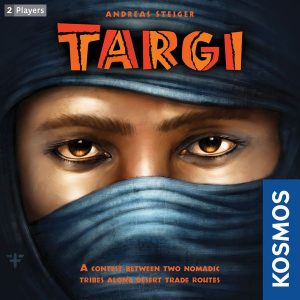Targi Review

By MARK WILSON

Year Published: 2012
Players: 2
Playing Time: 60 Minutes
Targi – The Premise
Targi is a moderately abstract worker placement game. It is for 2P only. Like many in that genre, you’ll be acquiring resources in order to acquire points. In this case, there are four core resources (three Goods and Gold) and the point engines are tribal cards, which you’ll be purchasing and then playing to your personal 3×4 tableau of tribal cards. There are multiple tribal card types, and if you form a row of the same tribe – or all different tribes – there’s a bonus in addition to the cards’ flat VPs.
The game “board” is a 5×5 grid of cards, and you’ll have three Targi (meeples) to play around the edge on cards that have an ability tied to them (gain a resource, trade for Goods, etc.). You can’t play in the center 3×3, but where your perimeter meeples bisect in the center are up to two additional actions you’ll get to take. You’ll also get to take your actions (three outside and two center) in any order when it’s your turn.
Meanwhile, there’s a “robber” meeple that traverses the perimeter (and also acts as a round clock and endgame timer) that will prevent you from placing on one perimeter space. At regular intervals he also steals resources or VPs from you, which you can mitigate occasionally.
The Components
Nothing’s bad here, but the art also isn’t going to sell this, and the 5×5 card tableau, which is always the same around the perimeter, is begging for a small, foldable board with those spaces printed on it. They could have done better.
The Strategic Twist
Targi works well, and is a unique spin on worker placement, because of the bisecting mechanic, which adds a lot to consider, not simply which of the perimeter spaces is best, but whether or not you can strategically utilize the center actions they map to. Additionally, this is a 2P game, so after a few plays you’ll start to see some of your opponent’s plans and devise ways to frustrate them. It’s entirely possible to stick your opponent with only horrible options for their last meeple placement. Conversely, it’s always possible to find a brilliant combination of actions that allow you to purchase and place multiple tribal cards on a turn, or accumulate unexpectedly large amounts of resources.
The other pleasant strategic idea here is that you can do your actions in any order. This introduces some risk/reward moments where, for example, you’re hoping for the right card draw to be able to complete two tribal cards in a turn instead of just one, but it can only happen with the right sequence of actions.
The longer strategy involves targeting specific tribal card types to maximize your tableau bonuses, and to buy tribal cards early that might be less VPs but come paired with a mildly beneficial ability or benefit. So eventually, not only are you worrying about whether or not you can purchase something, but also what type it is and whether your opponent wants it as well.
It’s all quite clever and satisfying, and the blocking is not so direct that it ever feels personal.
Tactics Vs. Strategy Vs. Randomness
There are some random card draws, specifically in the edge abilities that allow you to blind-draw a tribal card or resource card, but make no mistake, this is a highly tactical game. I mentioned long-term strategy above, and there is indeed a little bit of that, but this isn’t high strategy, and the “engine building” elements (mostly involving tribal card benefits that can be ongoing) are present but never central. The core of this is the round-to-round tactics of what the best combo of meeple intersections will be while minimizing your opponent’s opportunities.
Criticisms & My Take On Them
I’ve seen two criticisms in reviews and comments. The first is that some feel as though there are “right” answers on meeple placement that are obvious and thus uninteresting. I’ll admit to having seen this, like when a Coin card comes out in a coin-starved game. The “right” move seems to be to grab its row or column, but then the second player blocks that by grabbing the other row/column. Then the first player takes Fata Morgana to be able to grab it anyway. And if it’s in Morgana’s column, you go there first. Other examples are more rare, but occasionally exist when – for example – there’s only one tribal card you or your opponent can conceivably build. What I outlined isn’t the only possible play, but it sure feels like I’m playing sub-optimally if I do anything else.
The second criticism is that multiple plays start to feel the same. There are only so many resource types and tribal powers. We’ll come back to this.
I started to buy into both of those critiques. But I think Targi is a victim of its own ambition. Take literally any other duel-style 2P game, like Lost Cities or Jaipur. These are great, well-regarded games, but aren’t they just the same thing over and over? And aren’t there occasionally super-obvious plays? Of course there are. In fact, there’s a fair amount of both.
Targi feels bigger to us, both literally and conceptually. So we move the goalposts, so to speak, and start comparing it to lengthier, meatier Euro games, instead of lighter 2P games that we’d never hold to the same standard. Targi exists somewhere in the middle of those, both in length of play (games will last 45-60 minutes) and amount of complexity, depth and options. So there aren’t necessarily easy comparisons.
So my response to the criticisms? Yeah, there’s some repetition and the occasional obvious play. And maybe they’ll sour the experience for some. But there are also dozens of opportunities in any game to use your creativity to discover an interesting way to squeeze out a better outcome. At worst, I’d say that Targi isn’t a game I’d want to chain-play for fear of feeling those negatives more acutely. As an occasional pull, though, it remains solid.
Who Won’t Like This
I’ve read that the designers did their cultural homework, which is cool, but I’ll be honest and say I don’t get a huge sense of any particular cultural setting here. Maybe there’s a rich culture it’s drawing from, but in practice it just looks like resources in a generic desert setting. So fans of high theme may be turned off. If you want an engine-builder, this also isn’t quite it. The tactical considerations are brilliant, though.
The Expansion
The game has an expansion, called — amusingly enough — Targi: The Expansion.
I’m moderately intrigued but haven’t played. On the one hand, it has new new card types and tribal abilities, which are exactly what will give the game fresh new legs for some gamers. On the other hand, it introduces three new cards outside the 5×5 tableau where you can go instead. They’re big bonuses to account for the extra actions you’ll be losing, but it also saps some of the intrigue from the bisection puzzle that is at the heart of the game. I’m wary of mechanics that decrease player interaction in games that depend on that interaction for their tension. I’ll be happy to try it though.
You May Also Like
I’m gonna break my routine and throw in a plug for an obscure game I used to own, because it scratches a similar itch: Oddville. It’s slightly deeper on the engine builder side but packs a lot of both tactics and strategy into a compact, Euro-style worker placement, tableau builder. It’s satisfying in that same “middle ground” way that Targi is, between fillers and bigger Euros, and takes a similar amount of time and table space as well as similar amounts of brain power. If you love Targi, it may be worth digging up a copy of this one as well.
Targi – Conclusions
Targi’s a unique thing, not only because of its clever worker placement twist and the myriad possibilities that spring from it. It’s also unique because my favorite 2P games are either lighter and quicker, or impossibly deeper (Chess, Go, other abstracts, etc.). Mechanically, Targi fits right in with gateway or “next step” worker placement and tableau builders that hold more players, and it doesn’t sacrifice any of its mechanical crunch for being a distilled, 2P experience. I feel like it belongs next to Stone Age or Wingspan as much as the aforementioned Lost Cities (which I enjoy, so this isn’t a criticism of that game). For that reason, though, it fills a valuable niche for many fans of good 2P games.
I don’t want to play too often. I think eventually I’ll have seen enough generic resource cards in a generic desert and will have fought tooth and claw over enough coins, that I’ll need extended breaks between plays. When I do play, though, I’m confident that I’ll be treated to an enjoyable, deeply tactical struggle.
…
For more content, or just to chat, find me on Twitter @BTDungeons, and if you enjoy my work, be sure to subscribe on Youtube!
Share
Recent Posts
Categories
- All (350)
- Announcements (4)
- Board Games (203)
- DMing (28)
- Game Design (16)
- Playing TTRPGs (22)
- Reviews (189)
- RPGs (142)
- Session Reports (91)
- Why Games Matter (9)